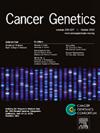Integrating radiomics and gene expression by mapping on the image with improved DeepInsight for clear cell renal cell carcinoma
IF 2.1
4区 医学
Q4 GENETICS & HEREDITY
引用次数: 0
Abstract
Background
Radiomics analysis extracts high-dimensional features from medical images, which are used to predict outcomes in machine learning (ML). Recently, deep-learning methods have become applicable to image data converted from nonimage samples.
Purpose
This study conducted a comparative analysis of outcome-prediction performance using radiomics with a conventional ML approach and deep-learning (DL) approach utilising DeepInsight. Furthermore, we enhance the DeepInsight model by integrating radiomics features with gene expression data. This integration aims to improve predictive power and provide a more comprehensive understanding of ccRCC, ultimately contributing to more personalized and effective treatment strategies.
Methods
A total of 142 patients with clear cell renal cell carcinoma who underwent surgery were divided into training and test datasets. Radiomics features were extracted in the entire tumour region from CT images. The two-year disease-free survival was predicted using ML and DL. ML was used for selective features after LASSO regression. ML algorithms were employed for classification, including the support vector machine, k-nearest neighbour, and neural network classifiers. For DL, radiomics features and gene-expression data were converted into image data with DeepInsight, and classification tasks were performed with DL techniques such as AlexNet, SqueezeNet, and InceptionNet.
Results
For ML, 17 prognosis-related radiomic features were selected from the LASSO regression. The ML accuracy was 76.5 %, 71.4 %, and 78.1 % for the support vector machine, k-nearest neighbour, and neural network models, respectively. For DL, the accuracies were 76.7 %, 83.1 %, and 85.4 % for AlexNet, SqueezeNet, and InceptionNet, respectively. Furthermore, the integrated DeepInsight models exhibited the highest accuracy of 90.9 %.
Conclusion
The proposed DL approach utilising DeepInsight demonstrated a significant improvement in outcome-prediction performance compared with the conventional ML approach. Furthermore, the integration of DL with radiomics features and gene-expression data effectively captures the relationship between biological information and image data, rendering it a promising tool for enhancing outcome-prediction capabilities.

利用改进的DeepInsight在透明细胞肾细胞癌的图像上定位,整合放射组学和基因表达
遗传组学分析从医学图像中提取高维特征,用于预测机器学习(ML)的结果。最近,深度学习方法已经应用于非图像样本转换的图像数据。目的:本研究使用放射组学与传统ML方法和使用DeepInsight的深度学习(DL)方法对结果预测性能进行了比较分析。此外,我们通过整合放射组学特征和基因表达数据来增强DeepInsight模型。这种整合旨在提高预测能力,并提供更全面的ccRCC了解,最终有助于制定更个性化和有效的治疗策略。方法将142例行手术治疗的透明细胞肾细胞癌患者分为训练组和测试组。从CT图像中提取整个肿瘤区域的放射组学特征。用ML和DL预测两年无病生存期。LASSO回归后,ML用于选择特征。使用ML算法进行分类,包括支持向量机、k近邻和神经网络分类器。对于深度学习,使用DeepInsight将放射组学特征和基因表达数据转换为图像数据,并使用AlexNet、SqueezeNet和InceptionNet等深度学习技术执行分类任务。结果对于ML,从LASSO回归中选择了17个预后相关的放射学特征。支持向量机、k近邻和神经网络模型的ML准确率分别为76.5%、71.4%和78.1%。对于深度学习,AlexNet、SqueezeNet和InceptionNet的准确率分别为76.7%、83.1%和85.4%。此外,集成DeepInsight模型的准确率最高,达到90.9%。与传统的机器学习方法相比,使用DeepInsight的深度学习方法在结果预测性能上有显著提高。此外,DL与放射组学特征和基因表达数据的集成有效地捕获了生物信息与图像数据之间的关系,使其成为增强结果预测能力的有前途的工具。
本文章由计算机程序翻译,如有差异,请以英文原文为准。
求助全文
约1分钟内获得全文
求助全文
来源期刊

Cancer Genetics
ONCOLOGY-GENETICS & HEREDITY
CiteScore
3.20
自引率
5.30%
发文量
167
审稿时长
27 days
期刊介绍:
The aim of Cancer Genetics is to publish high quality scientific papers on the cellular, genetic and molecular aspects of cancer, including cancer predisposition and clinical diagnostic applications. Specific areas of interest include descriptions of new chromosomal, molecular or epigenetic alterations in benign and malignant diseases; novel laboratory approaches for identification and characterization of chromosomal rearrangements or genomic alterations in cancer cells; correlation of genetic changes with pathology and clinical presentation; and the molecular genetics of cancer predisposition. To reach a basic science and clinical multidisciplinary audience, we welcome original full-length articles, reviews, meeting summaries, brief reports, and letters to the editor.
 求助内容:
求助内容: 应助结果提醒方式:
应助结果提醒方式:


